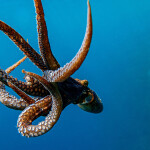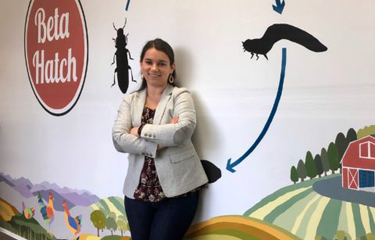Virginia Emery is the founder and CEO of Beta Hatch, a Cashmere, Washington, U.S.A.-based company founded in 2015 to develop insect-rearing technology to converts organic waste directly into high-value proteins, oils, and nutrients for aquafeed. Last month, the company secured Series A1 funding, which brought in USD 3 million (EUR 2.7 million), increasing the company’s total funding to nearly USD 10 million (EUR 9.1 million), including USD 4.6 million (EUR 4.1 million) in state and federal funding.
Emery spoke with SeafoodSource to discuss the company’s growth plans and its goals for working with the aquaculture sector to develop products and conduct research into the use of mealworms as a sustainably-sourced aquafeed.
SeafoodSource: When did you first start thinking about the potential commercial uses of mealworms, and how long did it take you to move from that idea to founding Beta Hatch?
Emery: The company is five years old, but the idea dates back to when I was working on my Ph.D. in entomology from Berkeley. My whole career, I have worked with insects and have been thinking about the value of innovating how we can use insects commercially. Beta Hatch grew organically out of a lot of interests I had, sort of a vison I had from my career, to see insects reach full potential in our food system. I’ve followed the development of insect use in the aquaculture sector – there have been pioneers doing this work for decades, but the commercial momentum on using bugs for aquafeed has been recent.
SeafoodSource: How large is the company currently and what is its funding situation?
Emery: We’re currently at 14 full-time employees, and we’ll be hiring a good number roles in next year. We have a strong technical engineering team but we still need to secure several more million dollars to finish building our facility. Our goal to get to profitability as fast as we can, so that’s really shaping how we’re building the company. We’re not going after hundreds of millions in investments, and we’re making sure we’re not subsidized by venture capital. I’m hoping each of our projects can be profitable within the first year of operation. From a company standpoint, that maybe creates a longer tail as there’s so much innovation to make what we do work.
SeafoodSource: What is the status of interest and investment in using insects in aquaculture?
Emery: There is now quite a lot of energy behind the sector in Europe, and that’s super-encouraging, as it’s great to see investments both in terms of dollars and research effort happening there. The U.S. is a little behind in innovating the sector. In part, that has to do with the emphasis in the U.S. on food production tends to be more on the livestock side. But aquaculture is rapidly growing in the U.S. as we’ve collectively realized that we’re a huge importer of seafood and aquaculture products from other countries, and as the aquaculture sector starts to bring more fishmeal imported into this country. With the focus on domestic production, now is the right time for this ingredient to be scaled in the U.S.
In terms of competition, we’re pretty much it for mealworms in North America, though there are two other major North American producers of black soldier flies – Enviroflight in Kentucky and Enterra in Canada, A lot of European producers are looking to bring their operations over here, and there has been talk for years of them opening facilities in California, but so far, they haven’t made a successful jump. It’s a very different labor market here, there’s a strong agricultural workforce and that presents different opportunities … We don’t have to have as much automation, and so they have to rethink the structure of how their businesses works. We can take a little bit different approach, and we’ve been able to take advantage of an opportunity zone in a rural area that has helped us capitalize on rural investment funds, as well as some other opportunities, that have combined to create a really great time for Beta Hatch to grow.
SeafoodSource: Why did you choose Cashmere, Washington, as your base of operations?
Emery: Cashmere is a rural town and there’s a huge amount of hydro power here. It’s really attractive for its low-cost electricity – there are already a lot of server farms established in this area because of it. It’s also in an agricultural area with lots of apple and tree fruit farms, and we will be using apple byproducts from processing as inputs. Additionally, land and labor are a lot more affordable than Seattle, where we got started. And we’ve received a lot of economic development help to encourage growth in the area. Lastly, it’s an opportunity to be closer to feedstock and our customers for our insect manure as organic fertilizer. For our aquafeed business, Washington state has a thriving aquaculture and hatchery scene, and it’s a great place to be selling our feed.
SeafoodSource: You’re in the processing developing your grow-out facility in Cashmere. How have you approached that process?
Emery: We’re building in an existing facility, an old juice factory. We’re converting some of that space from a big warehouse – around 30,000 square feet – into our insect production facility. Our plan is that we’ll be producing about one ton a day of insect product from this facility, and eventually, it is designed to be converted to full hatchery where we can produce 10 to 30 times more product. From a timeline perspective, we’ve had some delays due to the coronavirus, and we’re currently adjusting some of our timeline. We’ve done preconstruction and we’re hoping to get fully underway in the next few months to have it operational by next year.
The facility is located near a data center that produces a lot of waste heat, and our system we’ve designed will capture that waste heat to reduce the energy requirements at our facility. This type of colocation is a model we’d like to replicate as we grow, building in areas with other high-energy intensity applications where low-grade waste heat can be used.
SeafoodSource: What are your plans for expansion?
Emery: Our vision is certainly very global, as we see opportunity around the world. With [maker of agricultural products, animal nutrients, and specialty chemicals and ingredients] Wilbur-Ellis as our distributor, they’re helping us connect to customers around the world. We’re an ingredient manufacturer and we’re going to be working with existing feed manufacturers to sell our product to them to create the formulated diets. Additionally, we’re working with a lot of researchers at NOAA to be developing the right ways to process our product. Our vision is that in next few years, we’ll reach around country, and eventually the world.
SeafoodSource: Why did you choose mealworms, instead of the black soldier fly, which appears to be more popular in Europe as an insect-based ingredient for aquafeed?
Emery: Mealworms are definitely less popular, which is a bit of a mystery to me. As an entomologist and technologist developing this species, I have seen it’s got a lot of superior traits. The black soldier fly can grow faster, but even if the mealworm is slower-developing – and that’s not always the case, depending on how you treat them – mealworm is a dry-adapted species that has a much more simplified production process. With dry inputs, your growing system and product is easier to build and manage, and that reduces your cap-ex. The mealworm is also a heartier insect. Flies only live four days, but our breeder [mealworms] can live as long as four months, so it’s a much more adaptable insect. From a nutritional perspective, the amino acid profile of mealworms is balanced, and it has benefits over flies for digestability, It has higher fat content – around 10 to 20 percent more fat, and we describe it as the “bacon of bugs” – but they’re fatty little guys and we see advantages there as well. By giving them a diet of plant-based ingredients, we can actually create a mealworm with a fatty-acid profile very close to fish oil in terms of its omega-3 fatty acid content, so that’s a huge opportunity to replace not only protein ingredients but lipid ingredients in aquafeed diets.
SeafoodSource: Are you working with any industry partners to conduct any research on your product to see where your greatest opportunities lie?
Emery: We’ve spent several years developing these products for industry, and we just brought on a vice president of development to lead our efforts on this front. NOAA has been looking for new species that might serve as a replacement to growing Atlantic salmon in Washington, which is no longer allowed here. We’ve had a really promising development with them we’re hoping to announce soon, and some outstanding performance trials involving 100 percent mealworm diet tests – we’re getting performances similar to formulated diets. When you look at doing that with a single-ingredient diet, that’s really unheard of, but to me, it makes sense because insects are naturally a primary part of the diets of these fish, especially for salmonids and other river-based species. We’re seeing better health outcomes and better feed conversions. We have plans to conduct small-volume trials with several companies in the next year, and from there, it’s just a question of lining up more capacity.
SeafoodSource: Have you reached out at all to any seafood or aquafeed companies on potential sales channels or partnerships?
Emery: We are in early discussions with Skretting, and we are interested in talking to larger producers. The monthly demand for insect products right now exceeds current global supply, and while multiple insect producers are rushing to meet that demand, there’s a real opportunity for Beta Hatch to become a dominant player. We have a model that can rapidly scale to meet that need and scale seamlessly, so we’re not concerned about overproduction. But we’re really starting to see companies like Skretting and Cargill take insects more seriously – and I think that’s going to spur a lot of growth in the sector. We’re excited to work with real innovators and technologists and we hope to continue to make connections with the nutrition divisions of each of these companies we’re in touch with.
But there is a chicken-and-egg problem in that large companies want large volumes to sign a contract, but small companies can’t scale without demonstrated production. So what we’ve been saying is that it’s going to take a combined effort of large players in the sector to try out new products and methods and to see what works. We need patience to figure out how to scale our volumes, but we are definitely within a few years of this becoming a major ingredient in the marketplace. We’re excited to learn more about the seafood industry to see where our products can have most value, and see how their needs continue to evolve, especially as supply chains are evolving so quickly now [during the COVID-19 crisis].
Photo courtesy of Beta Hatch







